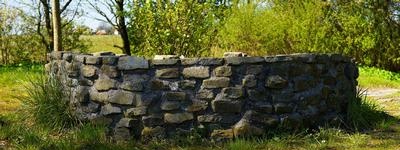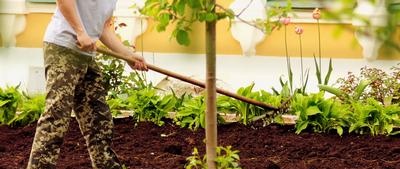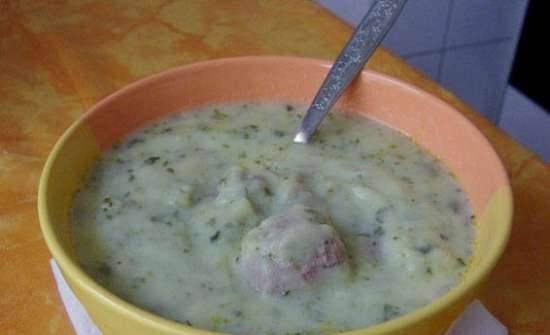|
 Kabardino-Balkaria occupies a picturesque place in the foothill zone of the central part of the North Caucasus. Kabardino-Balkaria occupies a picturesque place in the foothill zone of the central part of the North Caucasus.
The fertile valleys of the republic are spread out at the foot of the two-headed giant Elbrus (called Oshkhamaho by the Kabardians - the mountain of happiness). The legends of the Nart epic praise the happiness and joy of those living at the foot of Elbrus.
Happiness and joy are blessed nature. There is even a saying that "here the bone also gives roots."
Even the winds that in other places blow and dry out the soil, blow off snow, increase erosion, as a result of which the roots of fruit trees develop poorly, the trees become unproductive and die off prematurely, here they are of thermal origin - mountain-valley, have a beneficial effect on plants.
There is a dense river network in Kabardino-Balkaria. The high-water mountain rivers Malka, Baksan, Chegem, Cherek, Urukh and their countless tributaries and branches flow through its territory every 15-20 km. They all merge with the Terek, which washes the land masses of the republic.
Kabardino-Balkaria has 650 thousand hectares of agricultural land, all of which have been developed and distributed among state and collective farms. Systems for the placement of fruit trees and vineyards on the slopes have been developed, but alluvial-pebble deposits on numerous river terraces are not used. They have long been considered unsuitable for the cultivation of grain, industrial and vegetable crops. They serve as short-term grazing for livestock and partly poor haymaking, since the sparse grassy vegetation on them burns out at the beginning of summer.
In the central part of the North Caucasus, such lands occupy more than 400 thousand hectares. Only in Kabardino-Balkaria there are about 50 thousand hectares. Many gardeners in our country believed that the close occurrence of the pebble layer to the soil surface depressingly affects fruit trees.
But the candidate of biological sciences A. Kh. Avsaragov proved the opposite.
Here is what he told about the work carried out by the Kabardino-Balkarian experimental gardening station.
- On vast expanses of river sediments, I was always surprised by the rarely growing wild apple and pear trees. Their appearance, frankly, was very depressed. But they still grew and bore fruit. This suggested that if they were drunk, they would come to life. Such trees were fenced off and watered many times. In the first year they had a good growth of shoots and the leaves instead of small and pale ones became green and large. The trees laid new fruit buds and the next year they bore fruit. Consequently, there is a sufficient amount of nutrients in the underlying sediment layers.
We must not forget that the sediments were formed, or, as their very name shows, "deposited" by the fast-flowing waters of mountain rivers for centuries. But until they formed modern channels, they flowed and spilled over much larger areas. They often changed directions and channels, covering the surface of a given area with a new pebble layer, each time depositing all chemical elements with sand and silt in the sediments. There were frequent cases when a new pebble layer covered already formed chernozems, which is why second humus horizons, or the so-called "buried" chernozems, are found in the sediments at different depths.
Therefore, sediments cannot be considered "poor" lands. It was necessary to study their chemical composition and physical and mechanical properties.
Having chosen a place for laying an experimental garden between the rivers Urvan and Cherek with an area of 160 hectares, calling it "Mesopotamia", we began research.
Determined the mechanical composition of sediments by the Robinson method, found that pebbles adjoin one another part, and not entirely, forming gaps occupied by sandy and silty fractions. And this combination of mechanical fractions and pebbles provides even better aeration in the sediments than in the soils of mountain gardens.
Our studies of the chemical composition of sediments at different depths revealed the presence of large reserves of nitrogen, phosphorus, potassium, as well as manganese, zinc, aluminum, molybdenum and other trace elements. In some areas, the plantation was raised, leveled and loosened, in general, the planning was carried out in the usual way, but this turned out to be an unnecessary matter.
In order to create highly productive gardens on them, the upper sediment cover should be protected in every possible way due to the correct soil content in wide aisles in the near-trunk strips, and not loosening, because then the gravels lose their natural mixture with fine earth, are carried to the surface and after the first rains are completely washed off , forming a "field of peats".
When laying a garden on such lands, you only have to dig holes and cut irrigation furrows, and keep the rest of the area in its natural form.
They dug holes with a small excavator on a tractor with a bucket (220-250 planting holes per working day). Then they were filled with fine earth and supplemented with black earth, which was imported from the nearest site. Observing agrotechnical rules, we planted seedlings. Then the planting hole was leveled with the soil surface and carefully mulched with pebbles removed from it during digging.
Slopes are very convenient for irrigation. Fruit plantations can be watered without planning, using furrows.
It is best to stamp the furrows, that is, to make them by pressing the soil. The furrow width should be only 10-15 cm, which will ensure normal filtration of irrigation water, but subject to slow flow. And you can slow it down using the same pebbles, making drops out of them.
Now "Mesopotamia" has become a kind of botanical garden. 160 hectares of plantations are represented by many fruit crops. Trees are placed 6X6 and 6X3 meters. Each experiment is repeated 4 times. There are apple trees and pears on vigorous rootstocks, on dusen and on paradise, pear on quince. There are experiments in which 1250 and 1800 trees are placed on a hectare. The Jonathan apple tree is planted on a mixture of dusen. Low-stems quickly enter industrial fruiting. Better placement of 6X3 trees, no spacing required.
 We water young gardens at least twice in winter and six or even seven times in spring and summer. Full-grown plantings themselves shade the soil well and it evaporates less moisture, creating a better microclimate in the garden. In addition, due to the fall of leaves and the decomposition of herbaceous plants in the aisles and inter-stem strips of such a garden, a highly humus cover of mulch is formed. We water young gardens at least twice in winter and six or even seven times in spring and summer. Full-grown plantings themselves shade the soil well and it evaporates less moisture, creating a better microclimate in the garden. In addition, due to the fall of leaves and the decomposition of herbaceous plants in the aisles and inter-stem strips of such a garden, a highly humus cover of mulch is formed.
Now there are disagreements in the use of pesticides. It seems to me that there is no need to accustom trees to them from an early age.
It makes no sense to breed the Williams pear variety on a low-growing rootstock, since the trees of this variety are stunted in themselves.
As known, Reneth Champagne in the Crimea begins to bear fruit at the age of 18, and here, on the drifts, at the age of 3.
You saw all the plantings in "Mesopotamia". The trees are pleasing to the eye, the crowns are green, the growth is good, there are no signs of oppression. In young plantings, almost 100% survival rate. The whole idea of reclaiming sediment, essentially waste land, for fruit plantations is aimed at creating on the basis of irrigation the most productive gardens without tillage between the rows, not counting only one cutting or "stamping" furrows and care for them. They dig planting holes, but after planting the seedlings, they are also covered with a stone mulch cover, therefore, near-trunk circles during the life of fruit trees do not require processing.
On sediments, all types of work, sometimes difficult to perform and requiring large costs and funds, generally disappear, since these lands cannot be loosened, and even more so kept under black steam.
On sediments, on an area of 160 hectares, we are studying the best zoned varieties of apple, pear, plum, cherry plum, cherry, cherries, peach and various forms of walnut.
In trees with stone mulch cover and irrigation, the total growth in two years is four times greater than on chernozem under black fallow, and four and a half times than on the same sediments without stone mulch cover and irrigation. At the same time, the trees not only grow rapidly, but some of them, in the second year after planting in the garden, bear fruit and lay many fruit buds for the next year's harvest. It must be assumed that under favorable conditions of pollination using bees all of them in 3-year-old plantings will enter into mass fruiting. It is known that the Delicious apple tree is considered a fast-growing variety. However, such an early entry into fruiting (at 4-5 years) is unusual even for him.
None of the agrotechnical measures on the sediments has such an effect on growth and entry into fruiting as stone mulch in combination with irrigation.
This mulch contributes to the accumulation of moisture in the soil and due to winter precipitation. Rainwater, as well as the water that forms on the stones when the snow melts, flows freely, as in summer, between the stones into the soil, and they themselves dry out quickly. This cover also improves the physical properties of the soil. It is not destroyed by direct raindrops, even when the rains are heavy rain. Since there is always more moisture under the stones, earthworms accumulate here, which form countless passages in the soil, which contributes to an even better penetration of water and air into its deep layers.
The cut grass mulch also serves as a soil erosion protection agent. In addition, a good humus layer is created.
The sod-humus system of soil maintenance and stone mulch cover in near-trunk circles will make it possible, on the basis of irrigation, to create highly productive industrial gardens on sediments with the lowest cost per unit of production. Such a system of keeping the soil on sediments makes it possible to place fruit trees more densely than on ordinary lands. Apple trees should be grown here mainly on dusen stocks, and pears on quince stocks. In this case, 555 trees with wide row spacing of 6 m are placed on a hectare. On vigorous rootstocks, apple trees require a feeding area of 6X6, pears - 6X5, plums - 6X3 or 6X2.
From the above, we can conclude. The centuries-old people's experience, as well as our studies, show that the alluvial-pebble deposits of river terraces can be developed for fruit plantations, which is of great national economic importance, since there are a lot of these essentially waste lands not only in the North Caucasus, but also in other parts of the country.
A. X. Avsaragov, V. Novikova
|
 Kabardino-Balkaria occupies a picturesque place in the foothill zone of the central part of the North Caucasus.
Kabardino-Balkaria occupies a picturesque place in the foothill zone of the central part of the North Caucasus. We water young gardens at least twice in winter and six or even seven times in spring and summer. Full-grown plantings themselves shade the soil well and it evaporates less moisture, creating a better microclimate in the garden. In addition, due to the fall of leaves and the decomposition of herbaceous plants in the aisles and inter-stem strips of such a garden, a highly humus cover of mulch is formed.
We water young gardens at least twice in winter and six or even seven times in spring and summer. Full-grown plantings themselves shade the soil well and it evaporates less moisture, creating a better microclimate in the garden. In addition, due to the fall of leaves and the decomposition of herbaceous plants in the aisles and inter-stem strips of such a garden, a highly humus cover of mulch is formed.









